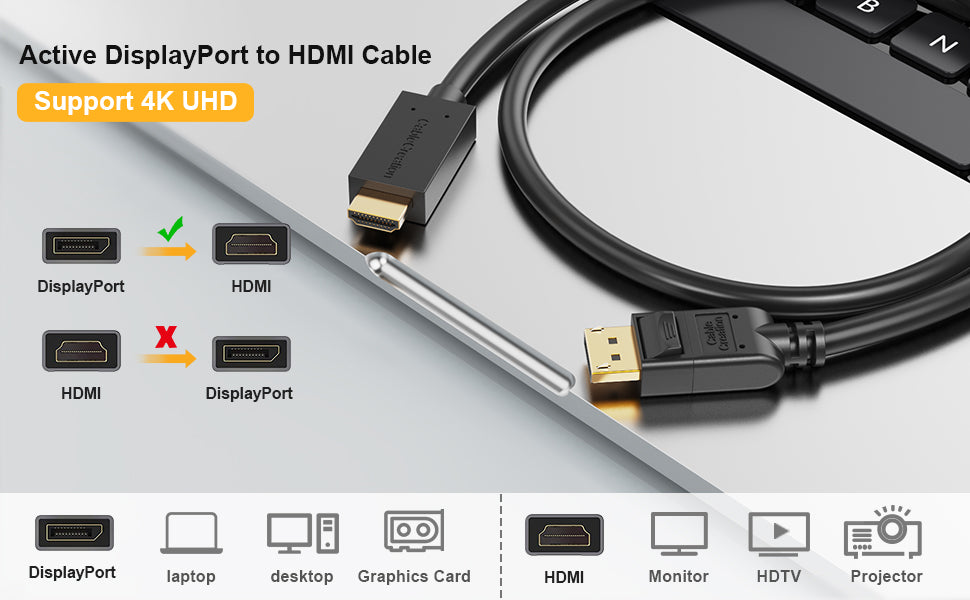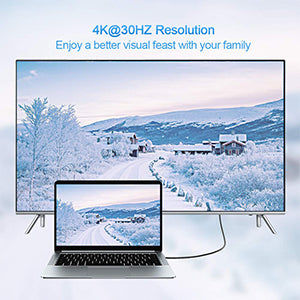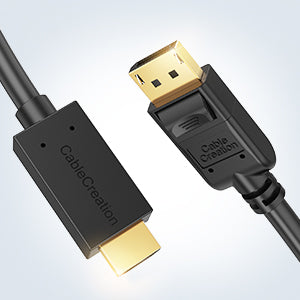Overview


Read Before You Buy
It's not for the montior with DisplayPort input, it's an uni-directional adapter. It will NOT work if your video source is HDMI and monitor is with DisplayPort input. Another solution, HDMI to DisplayPort with external power input is required.
What is the difference between a passive and active DisplayPort converter?
When you convert video from a source that uses DisplayPort or Mini DisplayPort to DVI or HDMI (for example, a computer to a monitor), you will need to consider the difference between passive and active adapters.
If the source supports dual-mode DisplayPort (also known as DP++), then you can use a passive adapter because the source can perform the conversion. If the source does not support DP++, then you need to use an active converter, which includes additional chips to perform the conversion.
Passive Adapters
Passive adapters are less expensive since they do not need to include additional chips. A quick way to check whether you can use a passive adapter is to see if the DisplayPort or Mini DisplayPort source has the DP++ symbol above it. The symbol is a D with a P inside of it, with two + signs to the left, one on top of the other.
Active Adapters
Active adapters use additional chips to make the conversion inside the adapter, regardless of whether the source supports DP++. This means that active adapters are more expensive than passive adapters.
If you want to use multiple monitors with the same computer, you should use an active adapter because some video cards cannot run the maximum number of monitors while using DP++. This is especially true if the computer has more than one DisplayPort or Mini DisplayPort connection. Check with your video card manufacturer to confirm which type of adapter you need for the setup that you would like to run.
Faq
Faq
Mirror and Extend Mode Settings
For MacOS: top left corner Apple icon-->System Preferences-->Displays-->Mirror or Extend Displays;
For Windows 10, press Windows key + P combination command-->choose Duplicate or Extend.
For Windows system laptop, if the external monitor could not work, please update the BIOS and graphic card driver from laptop official website.
When I connect host to external monitor, no image display.
Please make sure that the DP plug connects to host PC / laptop, HDMI plug connects to monitor. It's an unidirectional DisplayPort to HDMI cable, if you reverse the connection, it will NOT display anything.
When I connect host to external monitor, no image display.
Please make sure that the DP plug connects to host PC / laptop, HDMI plug connects to monitor. It's an unidirectional DisplayPort to HDMI cable, if you reverse the connection, it will NOT display anything.
I can't get 4K@30Hz resolution.
Firstly, please make sure that both of your host and monitor support 4K@30Hz;
Secondly, most HDMI monitors or TVs have different input sources, please choose the correct HDMI port that supports 4K@30Hz output;
Lastly, update the BIOS, graphics, and restart your laptop to try again. Also keep the connection stable, secure, and tighten.
Why i can’t plug DP end into PC/Laptop?
This is DisplayPort(DP), NOT Regular USB or HDMI Connector. Please connect the DP plug into the host PC / laptop with DP port.









